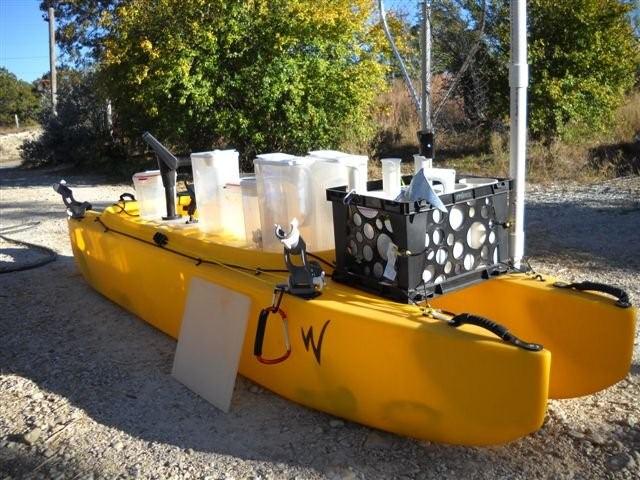The title of this piece should have been: “The Barge – A New Class of Fishing Kayaks, And Why It’s Even Worse Than You Imagine”… But long headlines are not elegant, so it got cut.
What is a ‘Barge’ kayak?
Most people know what the term Barge means when kayaks are referred to: It’s a big, wide, long, heavy kayak that’s hard to car top, hard to carry, hard to launch, hard to paddle, and hard to beach.
A Barge is a kayak that’s slow, and doesn’t track well, hence the expression “A barge to paddle”.
Manufacturers and vendors who offer barge kayaks often claim their products are so stable that you can stand up and fish from them. Some vendors would even get some dude to perform stability tricks in front of a camera, while standing up on their barge kayak, but few people fall for this kind of advertisement, and those who do soon learn not to trust improbable advertising, and they learn it the wet way, after they fall overboard :D…
So far, I don’t think I’ve provided any information that’s new to the reader, but I had to lay the foundation for this article on a common and solid basis, so bear with me.
Here is the main point of this article:
Barge Kayaks are Hazardous to Paddle and Fish From
Seriously, they can be, and that’s because fishing kayaks are used by real, everyday people like yourself, in real, everyday conditions. Life is neither a commercial video, nor a glossy ad.
Everyday people are not Olympic paddling champs, and they’re often both overweight to some extent, and not very fit. The average kayak angler is middle aged, and many kayak anglers are elderly folks. Unfortunately, these are the same people who would normally purchase a barge yak, because they are concerned about the instability of narrow sit-in and SOT kayaks, and may not want to pay for a W kayak.
So why is a slow and hard to paddle fishing kayak potentially hazardous for such people?
Simply because in the natural world, which is where real people paddle and fish, you’re bound to get into unfavorable circumstances – sooner or later, unless you paddle and fish in a tiny pond, preferably close to home. Such circumstances usually involve changes in the weather, and since everyone has experienced such things, there’s no point to elaborate on that.
When bad weather happens while you’re seated in your kayak, you’d rather not overturn it, of course, and it is assumed that barge kayaks can normally handle this challenge – not always, and not as well as W kayaks, though… unlike other kayaks that are too unstable for that. However, if you happen to be away from shore in bad weather, being in a barge kayak could turn out to be a bad experience for you, and it may even lead to an accident, because you could find yourself unable to get back to your launching spot, or worse – go back to shore in any part of it. If back to shore means getting back to a beach, and the place you’re paddling and fishing in is the ocean, or a big lake, you’re in trouble. Big time.
This is because big bodies of water (E.G. ocean, lake, big river) also have currents in them, and the combination of wind and current is just too powerful for you to deal with when you’re paddling a barge kayak. Waves would likely swamp you. You won’t be able to direct the kayak to safety, and you’d be drifting somewhere you don’t want to go to. When this happens, you may find yourself in an even worse situation as night comes.
So try to imagine yourself wet, cold and exhausted from useless paddling efforts, your back is killing you, and you’re drifting somewhere in the darkness, in your barge yak. Scary, eh?
Again, the heavier, older, and less fit you are, the higher the chances you’d let some kayak dealer sell you a barge yak, and at the same time the heavier, older and less fit you are, the more likely you are to get in trouble because you’re paddling such a vessel…
Well, life is unfair, sometimes, especially to those who don’t take it seriously, and don’t imagine worse case scenarios that unfortunately are part of many outdoor recreational sports, including kayaking and kayak fishing.
It doesn’t make much difference whether you propel your barge yak with a paddle or a pedal drive – You’s better not venture too far from shore with it, especially in unfavorable weather circumstances, or when there’s a good chance that the weather could change for the worse, because such change may very well be unfavorable, and even dangerous to you.
Do you have any questions for us?


